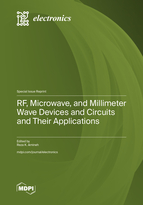RF, Microwave, and Millimeter Wave Devices and Circuits and Their Applications
A special issue of Electronics (ISSN 2079-9292). This special issue belongs to the section "Circuit and Signal Processing".
Deadline for manuscript submissions: closed (15 April 2025) | Viewed by 21282
Special Issue Editor
Interests: microwave imaging; microwave component design; antennas; microwave nondestructive testing of materials; microwave biomedical applications
Special Issues, Collections and Topics in MDPI journals
Special Issue Information
Dear Colleagues,
The recent progress in the development of cost-effective and compact high frequency circuits in the RF, microwave, and millimeter wave domains has significantly broadened their applications. While many of these technologies were only used in military applications several decades ago, with the new developments, their use in various civilian applications is growing rapidly. The objective of this Special Issue is to provide an overview of the current research on “RF, Microwave, and Millimeter Wave Devices and Circuits and Their Applications”, highlighting the latest developments and innovations in modern applications, including, but not limited to, the following: wearable sensing, imaging, communication systems, wireless power transfer, sensors, radar, micro-electromechanical systems, power generation and transmission, RFID, oscillators, resonators, and so on. We will also try to identify new challenges and opportunities for new applications.
Dr. Reza K. Amineh
Guest Editor
Manuscript Submission Information
Manuscripts should be submitted online at www.mdpi.com by registering and logging in to this website. Once you are registered, click here to go to the submission form. Manuscripts can be submitted until the deadline. All submissions that pass pre-check are peer-reviewed. Accepted papers will be published continuously in the journal (as soon as accepted) and will be listed together on the special issue website. Research articles, review articles as well as short communications are invited. For planned papers, a title and short abstract (about 100 words) can be sent to the Editorial Office for announcement on this website.
Submitted manuscripts should not have been published previously, nor be under consideration for publication elsewhere (except conference proceedings papers). All manuscripts are thoroughly refereed through a single-blind peer-review process. A guide for authors and other relevant information for submission of manuscripts is available on the Instructions for Authors page. Electronics is an international peer-reviewed open access semimonthly journal published by MDPI.
Please visit the Instructions for Authors page before submitting a manuscript. The Article Processing Charge (APC) for publication in this open access journal is 2400 CHF (Swiss Francs). Submitted papers should be well formatted and use good English. Authors may use MDPI's English editing service prior to publication or during author revisions.
Keywords
- Imaging
- Microwave circuits
- Millimeter wave circuits
- Oscillators
- Radar
- Resonators
- RF circuits
- Sensors
- Wearable sensing
- Wireless power transfer
Benefits of Publishing in a Special Issue
- Ease of navigation: Grouping papers by topic helps scholars navigate broad scope journals more efficiently.
- Greater discoverability: Special Issues support the reach and impact of scientific research. Articles in Special Issues are more discoverable and cited more frequently.
- Expansion of research network: Special Issues facilitate connections among authors, fostering scientific collaborations.
- External promotion: Articles in Special Issues are often promoted through the journal's social media, increasing their visibility.
- Reprint: MDPI Books provides the opportunity to republish successful Special Issues in book format, both online and in print.
Further information on MDPI's Special Issue policies can be found here.






